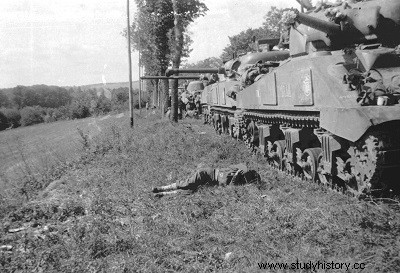
During the days of September 20, 21 and 22, the operations on the front of the 2nd C.A. had no other objective than to clarify contact with the adversary.
Starting from the road Lure Isle-sur-Doubs, the 1st D.F.L. General Brosset does not go more than 3 to 4 km before coming up against a continuous line of resistance, protected, on all routes, by abatis and innumerable mines.
More on north, General du Vigier's 1st D.B. was also blocked a little beyond Melisey on the road from Lure to Thillot. On September 23, the line of fire stabilized on the front of the 2nd Corps. However, on the same day, a letter addressed by General Truscott, commanding the 6th U.S. C.A., to General de Monsabert marks the first intervention, during this period, of the heavy mortgage which the movement of Americans from the U.S. Seventh Army moving north west of the Vosges. An American general humorously expressed this situation:"Two dogs tied by the tail and shooting in the opposite direction".
The resistance opposed to the 1st D.F.L. and to the 1st D.B. shows how quickly General Wiese, commanding the German XIX Army, managed to organize a strong, relatively deep and continuous defensive position. Showing the greatest energy, he restored order to the large units that had survived his long retreat and made the best use of the many reinforcements that had come from inside the Reich.
With the With the assistance of the Organization Todt and by requisitioning labor from the French population, he succeeded, in surprising time, in equipping a double line of defense covered by a glacis of a dozen kilometers and on which he concentrated the bulk of his army in order to gain the time necessary to complete, further back, the organization of a hauptkampflinie (main line of resistance). These are four divisions which occupy in front of us these advances and to the leaders of which Hitler promised, on September 21, the post of execution if they were to let go. However, the combined efforts of the 1re D.B. and the 1re D.F.L. manage to burst, on September 28, the advanced German positions and create a very clear salient as far as Plancher-les-Mines, at the same time blowing up the first lock giving access to the Vosges passes.
However, it appears that the breakthrough at Plancher-les-Mines occurred at the end of the right wing of the German forces defending the Belfort Gap. Further north the German device seems discontinuous and limited to the defense of communications nodes, as is the case of Thillot. Moreover, on our left, the Americans, having liberated Remiremont, intend to reach Le Tholy and Gérardmer shortly. In these conditions, the advance through the Vosges is not only possible but it is the only one for the time being.
Ultimately, General de Lattre thinks that the postponement of the effort of the 1st right army to its left can ensure penetration into Alsace before the severe cold and lead to the economy of a breaking battle in the Belfort gap by threatening the German divisions defending it with encirclement. So he plans to attempt the operation through the Vosges in the direction of Schlucht, taking Gérard mer as a springboard as soon as the Americans have delivered him to us. However, because of the resistance which is opposed to him in the direction of Gérardmer, the U.S. commander asks us to relieve as soon as possible his units which occupy the control of Rupt and the forest of Longegoutte on crest which separates, upstream from Remiremor the valleys of Moselle and Moselotte.
At the same time, the 2nd C.A. noted a general stiffening and rapid reinforcement of the enemy who blocked us in front of Le Thillot, Château-Lambert and Ronchamp. The time has therefore not come for an extension of our front.
No sooner had General de Lattre consented to this extension than General Devers, commanding the Sixth Army Group, informed him of his intention to move the center of gravity of the Seventh U.S. Army further north his southern army corps, the 6th, towards Sain Dié. Consequently, he asked the French 1st Army to entirely relieve its right division, the 3rd, from General O'Daniel. at the same time, the maneuver by Gérardmer la Schlucht escapes us.
So General de Monsabert proposes to take as a new base for our offensive the watershed line between the Moselle and the Moselotte, that is to say the Longegoutte ridge on which we will have to relieve the right units of the 3rd D.I. U.S. From there, we can still act in the direction of Hohneck by Cornimont, the lower and the upper valley of the Moselotte, which will to emerge in Alsace. This outlet is only a stopgap measure, but it is within our means. On October 2, General de Monsabert gave his orders for the operation to be launched on the 4th. The main action was entrusted to my division, the 3rd D.I.A., relieved from the front of the 1st C.A. tabors.
